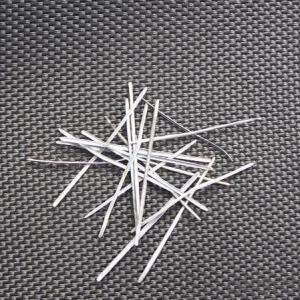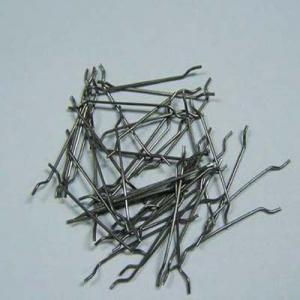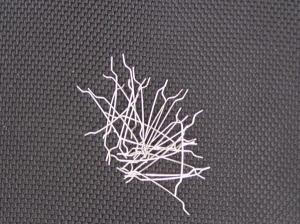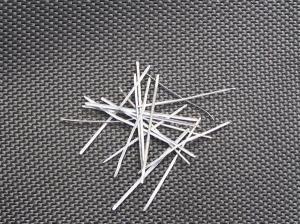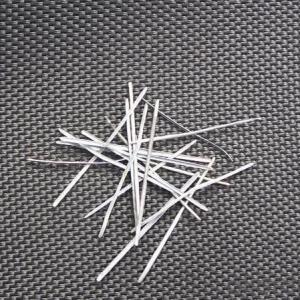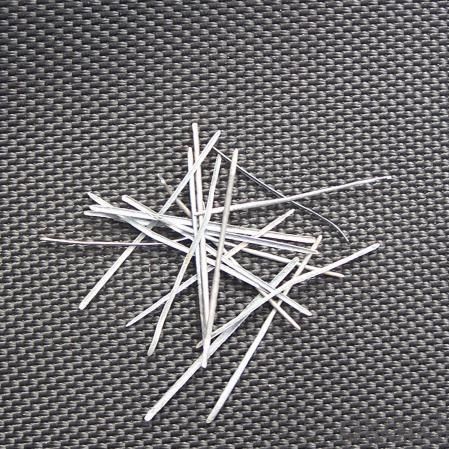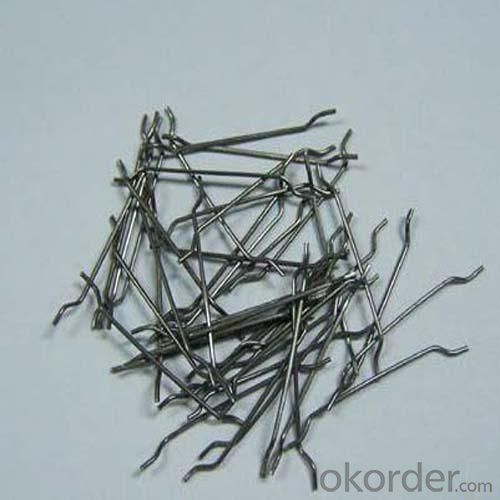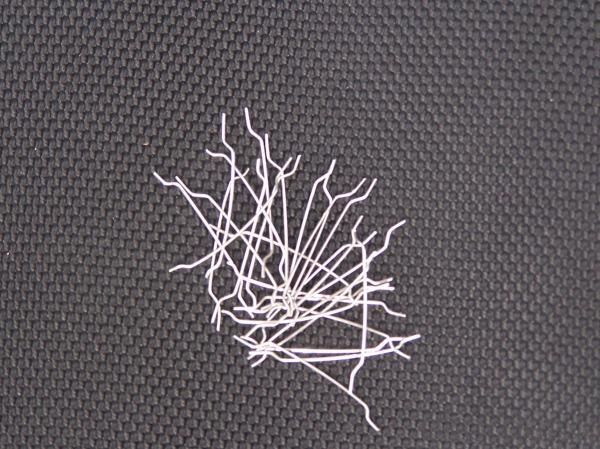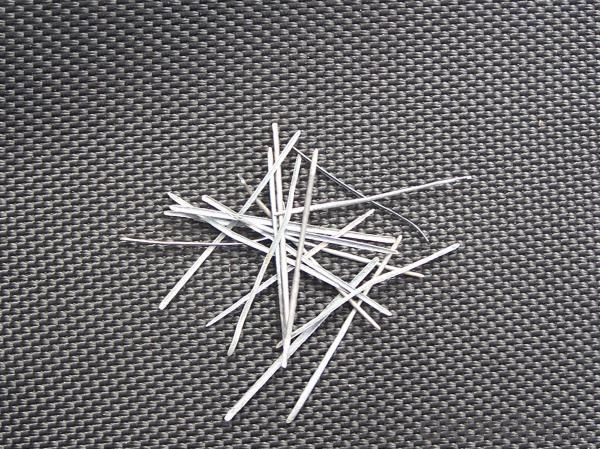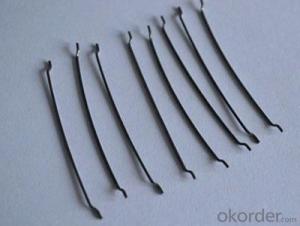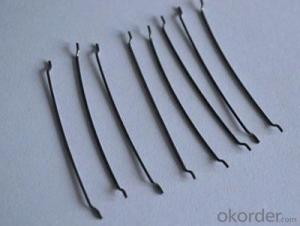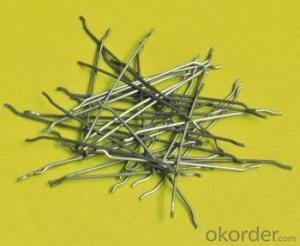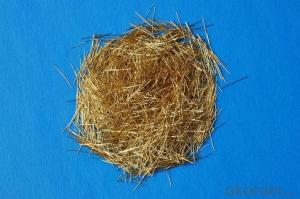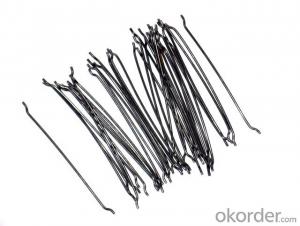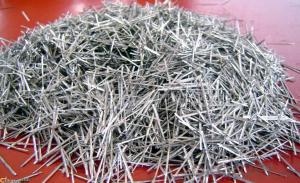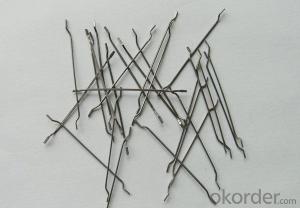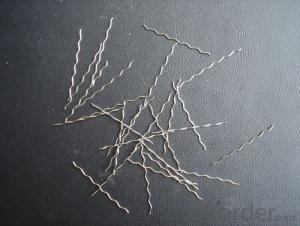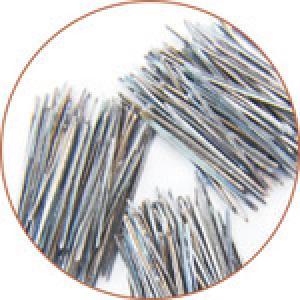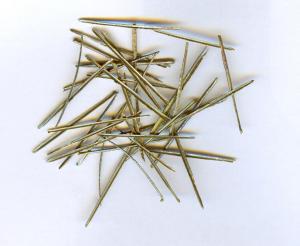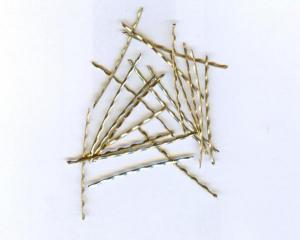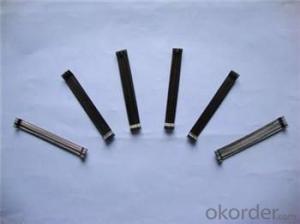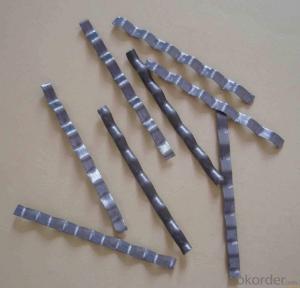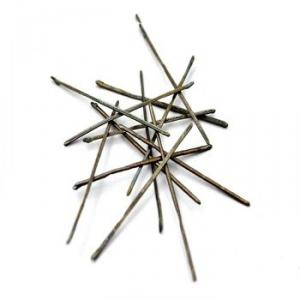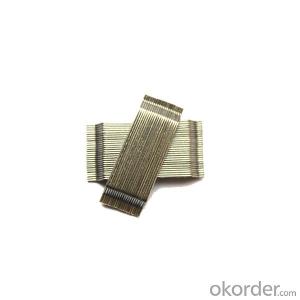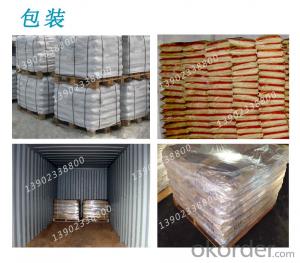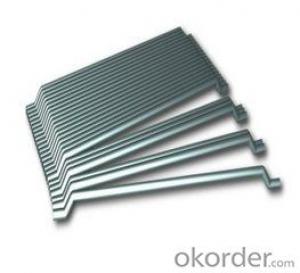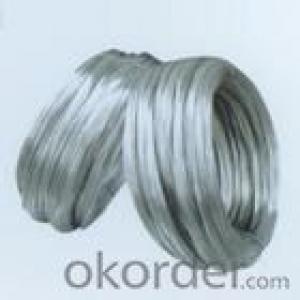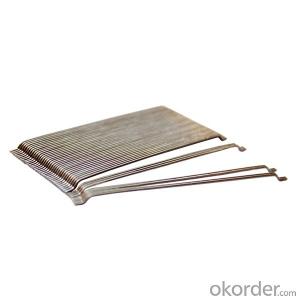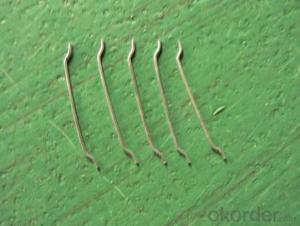Melt Extract Cold Drawn Stainless Steel Fiber 304
- Loading Port:
- China Main Port
- Payment Terms:
- TT or L/C
- Min Order Qty:
- 5 Tons m.t.
- Supply Capability:
- 5000 Tons per Month m.t./month
OKorder Service Pledge
OKorder Financial Service
You Might Also Like
General Information of Cold Drawn Stainless Steel Fiber 304
CMAX cold drawn stainless steel fiber is manufactured by high quality stainless steel wire, mainly used for castable requirements in refractory field, with high tensile strength and low ductility. Cold drawn stainless steel fiber is accomplished by high quality stainless steel wire, and is mainly used for refractory castables. CMAX steel fiber has the ultra-strong tensible strength and suppleness.
CMAX cold drawn stainless steel fiber can improve refractories performance and durability, decreasing cost.
Feature of CMAX Cold Drawn Stainless Steel Fiber 304
Improve refractories’ performance
Improve refractories’ longevity
Improve refractories’ durability
Significantly reducing downtime and maintance cost
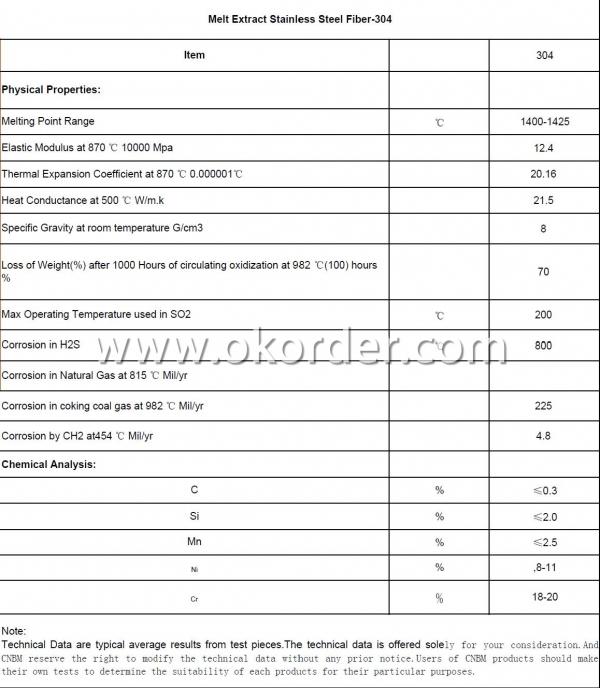
Application of CMAX Cold Drawn Stainless Steel Fiber 304
Refractory products
Precast
Castable project
Industrial furnaces
Other refractories project
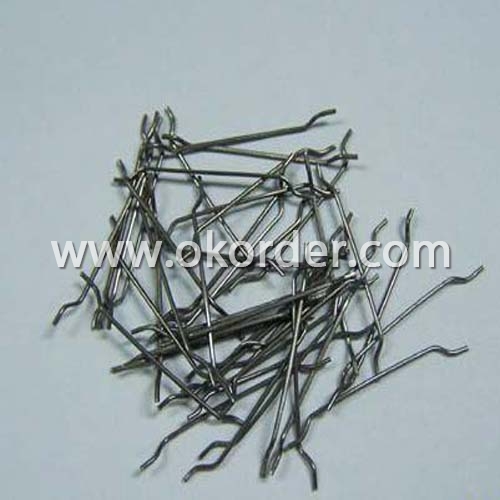
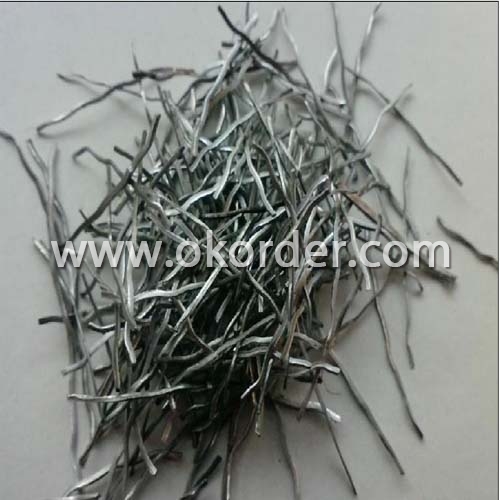
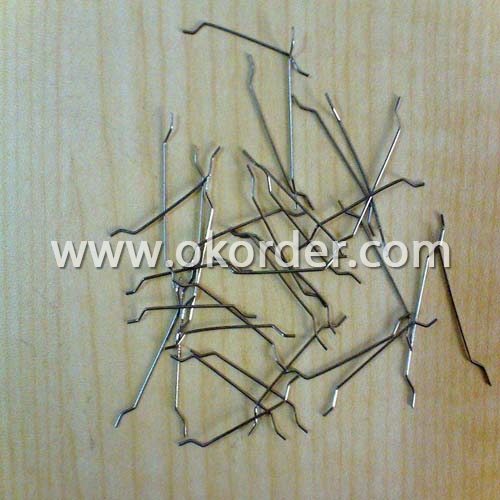
Our company has success in its melt extract stainless steel fiberproducts due to their cost-effectiveness and excellent insulating properties. We also have experience in melt extract stainless steel fiberapplication and would like to assist you in product selection, system design, and installation techniques. Our products of melt extract stainless steel fiber are in good quality and in best price.
- Q: Can melt extract stainless steel fiber be used in airport runways or taxiways?
- Yes, melt extract stainless steel fiber can be used in airport runways or taxiways. The use of stainless steel fibers in these areas provides numerous benefits. Firstly, the addition of stainless steel fibers enhances the overall strength and durability of the concrete used in constructing runways and taxiways. This increased strength helps to prevent cracking and deterioration caused by heavy aircraft traffic and extreme weather conditions. Furthermore, the use of stainless steel fibers can improve the resistance of the concrete to fatigue and abrasion, ensuring a longer lifespan for the runway or taxiway. This is particularly important in airport environments where constant heavy traffic and the presence of debris can cause wear and tear over time. Additionally, stainless steel fibers offer excellent resistance to corrosion, which is crucial in airport settings where de-icing agents and other chemicals are frequently used. By incorporating stainless steel fibers into the concrete mix, the runway or taxiway can withstand exposure to these corrosive substances, reducing the need for frequent maintenance and repairs. In summary, melt extract stainless steel fiber is a suitable material for airport runways and taxiways due to its ability to enhance the strength, durability, fatigue resistance, and corrosion resistance of the concrete used in their construction.
- Q: What is the recommended fiber dosage for melt extract stainless steel fiber in shotcrete?
- The recommended fiber dosage for melt extract stainless steel fiber in shotcrete typically ranges from 25 to 35 kilograms per cubic meter (kg/m3) of concrete. However, it is always recommended to consult the manufacturer's guidelines and consider specific project requirements to determine the exact fiber dosage for optimal performance.
- Q: How does melt extract stainless steel fiber improve the resistance to seismic loading in shotcrete?
- Shotcrete's resistance to seismic loading can be enhanced by the inclusion of melt extract stainless steel fiber. This fiber improves the overall structural integrity and ductility of the material, resulting in a stronger and tougher concrete mixture. When added to shotcrete, stainless steel fibers act as reinforcement, providing extra strength and toughness. This reinforcement helps to distribute dynamic forces, such as those experienced during earthquakes, more evenly throughout the material. By doing so, the concentration of stress points is reduced, minimizing the risk of structural damage. In addition to strengthening the shotcrete, stainless steel fibers also improve its bond with the substrate. This enhanced adhesion and cohesion are crucial in seismic loading scenarios, as they ensure that the shotcrete remains firmly attached to the underlying structure. This strong bond allows the shotcrete to effectively resist the lateral forces induced by seismic events. The high tensile strength and corrosion resistance of melt extract stainless steel fibers make them an ideal choice for seismic-resistant shotcrete. These fibers can withstand significant tensile stresses and do not degrade over time, even in harsh environmental conditions. This durability ensures that the shotcrete maintains its structural integrity and seismic resistance over the long term. In conclusion, melt extract stainless steel fiber enhances the resistance to seismic loading in shotcrete by strengthening the material, improving its bond with the substrate, and providing long-lasting durability. By incorporating these fibers into shotcrete mixtures, engineers can confidently design structures that can withstand the dynamic forces associated with seismic events.
- Q: Can melt extract stainless steel fiber be used in high-performance shotcrete mixtures?
- Yes, melt extract stainless steel fiber can be used in high-performance shotcrete mixtures. Stainless steel fibers are known for their high tensile strength, corrosion resistance, and durability, making them suitable for various applications including shotcrete. In high-performance shotcrete mixtures, the addition of stainless steel fibers can improve the overall performance of the material. The inclusion of stainless steel fibers in shotcrete can enhance its resistance to cracking, impact, and fatigue. These fibers act as reinforcement, providing additional strength and toughness to the shotcrete. They help to control shrinkage and reduce the formation of shrinkage cracks, which is crucial in high-performance applications where durability is a key requirement. Furthermore, stainless steel fibers can improve the ductility and flexural strength of shotcrete, allowing it to better withstand dynamic loads and harsh environments. This makes it particularly suitable for use in high-performance shotcrete applications such as tunnel linings, underground structures, bridge repairs, and other situations where high strength and durability are essential. It is important to note that the specific dosage and fiber length should be carefully determined based on the desired performance requirements and the characteristics of the shotcrete mixture. Consulting with a materials engineer or shotcrete specialist is recommended to ensure the proper selection and dosage of melt extract stainless steel fibers for high-performance shotcrete mixtures.
- Q: Can melt extract stainless steel fiber be used in parking garage construction?
- Yes, melt extract stainless steel fiber can be used in parking garage construction.
- Q: Does melt extract stainless steel fiber affect the workability of concrete?
- Indeed, the inclusion of melt extract stainless steel fiber in concrete can have an impact on its workability. Incorporating these stainless steel fibers into the concrete mixture can augment its viscosity and rigidity, thereby complicating the process of manipulation. Consequently, the workability of the concrete may be compromised, rendering it less fluid and more challenging to shape or mold. Nonetheless, the severity of this influence hinges upon the quantity and length of the stainless steel fibers employed, as well as the specific necessities of the concrete application.
- Q: Does melt extract stainless steel fiber improve the resistance to chloride ingress in shotcrete?
- Yes, melt extract stainless steel fiber does improve the resistance to chloride ingress in shotcrete. Chloride ions are known to cause corrosion in concrete structures, especially in marine environments or areas with high exposure to chloride salts. By incorporating melt extract stainless steel fibers into shotcrete mixtures, the concrete can have enhanced durability and resistance against chloride penetration. Melt extract stainless steel fibers are specifically engineered to provide reinforcement in concrete and shotcrete applications. These fibers are made from high-quality stainless steel and have excellent corrosion resistance properties. When added to shotcrete mixtures, the stainless steel fibers form a three-dimensional network within the concrete matrix, which helps to distribute stress and prevent crack formation. In terms of chloride ingress resistance, the presence of melt extract stainless steel fibers acts as a physical barrier that restricts the movement of chloride ions into the concrete. The fibers create a tortuous path for the chloride ions to follow, thereby slowing down their penetration rate. This significantly reduces the risk of corrosion initiation and propagation within the concrete. Furthermore, melt extract stainless steel fibers also improve the overall durability of shotcrete by increasing its resistance to freeze-thaw cycles, abrasion, impact, and other forms of deterioration. This extended service life further contributes to the enhanced resistance to chloride ingress, as the concrete remains structurally sound and less susceptible to chloride-induced corrosion. It is important to note that while melt extract stainless steel fibers provide significant benefits in terms of chloride ingress resistance, they should be used in conjunction with other corrosion mitigation measures, such as proper concrete cover, waterproofing systems, and appropriate concrete mix design. Additionally, the dosage and distribution of the stainless steel fibers within the shotcrete mixture should be carefully determined based on the specific project requirements and exposure conditions.
- Q: Can melt extract stainless steel fiber be used in parking garage structures?
- Yes, melt extract stainless steel fiber can be used in parking garage structures. Stainless steel fiber is commonly used as a reinforcement material in concrete to enhance its strength and durability. It can improve the resistance to cracking, impact, and corrosion in concrete structures, making it an ideal choice for parking garages. The melt extract stainless steel fiber is specifically designed to have high tensile strength and excellent bonding with concrete, ensuring the stability and longevity of the parking garage. Additionally, the stainless steel composition provides resistance to rusting and deterioration, which is crucial in structures exposed to harsh environmental conditions like parking garages. Overall, using melt extract stainless steel fiber in parking garage structures can significantly enhance their structural integrity and lifespan.
- Q: How does melt extract stainless steel fiber affect the rheology of self-compacting shotcrete?
- Melt extract stainless steel fiber can have a significant impact on the rheology of self-compacting shotcrete. Firstly, the addition of stainless steel fibers can improve the overall viscosity and fluidity of the shotcrete mix. The fibers act as a reinforcement and help to maintain the stability and flowability of the mix, preventing segregation and settlement during application. This is particularly important in self-compacting shotcrete, where a high degree of workability is required to ensure proper consolidation and filling of the desired areas. Moreover, the stainless steel fibers also enhance the cohesion and cohesiveness of the shotcrete mix. The fibers act as a bonding agent, improving the interparticle interactions and increasing the overall strength and durability of the shotcrete. This results in a more cohesive and stable material that is less prone to cracking and shrinkage. Additionally, the presence of stainless steel fibers can also impact the setting time of the shotcrete. The fibers can accelerate the hydration process and promote the early development of strength. This is beneficial in self-compacting shotcrete applications where rapid setting and early strength development are desired to allow for faster construction progress. Furthermore, the melt extract stainless steel fibers can also contribute to the overall ductility and toughness of the shotcrete. The fibers provide additional resistance against crack propagation and enhance the overall structural integrity of the material. This is crucial in self-compacting shotcrete, as it allows for better performance under dynamic loading conditions and enhances the ability of the material to withstand external forces. Overall, the melt extract stainless steel fibers have a positive effect on the rheology of self-compacting shotcrete by improving viscosity, cohesion, setting time, and overall durability. Their addition enhances the workability and performance of the shotcrete, making it a highly suitable material for various construction applications.
- Q: How does melt extract stainless steel fiber improve impact resistance in concrete?
- Melt extract stainless steel fiber improves impact resistance in concrete by enhancing its toughness and durability. The fibers, when added to the concrete mix, disperse uniformly throughout the material, creating a three-dimensional reinforcement network. This network acts as a reinforcement system, effectively absorbing and distributing the energy from impacts or external forces. As a result, the concrete becomes less prone to cracking or fracturing under sudden loads, thereby significantly enhancing its impact resistance.
1. Manufacturer Overview
| Location | Henan, China |
| Year Established | 2007 |
| Annual Output Value | Above US$ 60 Million |
| Main Markets | Mid East; Eastern Europe; North America |
| Company Certifications | ISO 9001:2008 |
2. Manufacturer Certificates
| a) Certification Name | |
| Range | |
| Reference | |
| Validity Period |
3. Manufacturer Capability
| a) Trade Capacity | |
| Nearest Port | Tianjin |
| Export Percentage | 31% - 50% |
| No.of Employees in Trade Department | 21-50 People |
| Language Spoken: | English; Chinese |
| b) Factory Information | |
| Factory Size: | Above 36,000 square meters |
| No. of Production Lines | Above 5 |
| Contract Manufacturing | OEM Service Offered |
| Product Price Range | Average |
Send your message to us
Melt Extract Cold Drawn Stainless Steel Fiber 304
- Loading Port:
- China Main Port
- Payment Terms:
- TT or L/C
- Min Order Qty:
- 5 Tons m.t.
- Supply Capability:
- 5000 Tons per Month m.t./month
OKorder Service Pledge
OKorder Financial Service
Similar products
Hot products
Hot Searches
Related keywords
